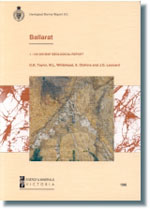GSV Report 101 - Ballarat 1:100 000 map area geological report
 |
| |||||||||||||||||||||||||||||||||||||||||||||||||||||||||
Product description:Download The downloadable version of this report is supplied in PDF format (22.2MB). Abstract This report describes the geology of the area covered by the Ballarat 1:100 000 mapsheet 7622. It gives a comprehensive account of the physiography, rock units, the geological structure and economic geology. Outlines of the regional geological setting, geological history, landscape evolution and a summary of previous geological work and literature references are also presented. The Palaeozoic bedrock is comprised of deep marine turbidites which have been differentiated into Cambrian (Saint Arnaud Group) and Ordovician (Castlemaine Supergroup) sequences. The petrography, provenance and depositional environment of the sequences is discussed. Slices of Cambrian metavolcanics (greenstones) have been thrust along the fault contact between the sequences. The petrography and geochemistry of these rocks is described. Several post-tectonic I-type granitic plutons of Late Devonian age have intruded the sequences to shallow levels. The characteristics of these rocks have also been described in detail. The Palaeozoic rocks were affected by two deformations. Silurian deformation (the Middle Silurian Benambran event?) is responsible for the relatively simple regional deformation and accompanying greenschist metamorphism of the turbidite sequences. Large thrusts characterised by intensely strained hanging walls of multiply-deformed schist are detachment faults which were active during regional deformation. There are detailed descriptions of all the structural fabrics with regional structures being named. The Middle Devonian Tabberabberan Deformation caused widespread but minor brittle faulting. Prolonged erosion in post-Palaeozoic times intensified after Cretaceous uplift. The evolution of the landscape and the cycles of Cainozoic sedimentation and volcanism are described in the context of this uplift. Previous ideas on the landscape evolution and the ages and distribution of the various Tertiary rock units are greatly revised. Significant gold mineralisation occurs in quartz reefs in the bedrock. The timing and controls on gold mineralisation are discussed. The distribution of reworked alluvial gold is described in detail. An overview of the extensive non-metallic resources and a summary of the groundwater aquifer systems are also presented. A comprehensive reference list and numerous photographs, diagrams and tables complement the text. These include cross-sections of the major goldfields, revised positions of the deep leads, radiometric dates and a summary of company mineral exploration. The text concludes with a detailed excursion guide designed to show the major geological features and economic mineral resources of the area. Bibliographic reference Taylor, D.H., Whitehead, M.L., Olshina, A., Leonard, J.G. Ballarat 1:100 000 map geological report. Geological Survey of Victoria Report 101. Related products:
| ||||||||||||||||||||||||||||||||||||||||||||||||||||||||||





